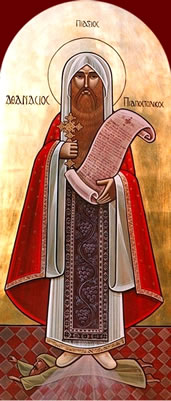Anonymous Church History: 3.4 – The emperor’s letter concerning the preparation of holy books
3.4.1 “Victor Constantinus Maximus Augustus, to Bishop Eusebius. In the city which bears our name, many people, gathered through God’s gracious care, have entrusted themselves to the holy church so that everything there grows rapidly. We thought it quite appropriate to build more churches there.
3.4.2 Therefore joyfully undertake the course of action we have chosen. It seemed proper to us to instruct your prudence to order fifty copies of the Holy Scriptures on fine parchment, easy to read and of portable size. They should be copied by skilled calligraphers well-versed in their craft. You know that they must be prepared and used for reading in the church.
3.4.3 Our clemency has sent a letter to the accountant of the diocese, instructing him to take care to supply everything necessary for the job.
3.4.4 Diligently see to it that the manuscripts are completed as quickly as possible. With this letter we authorize you to use two public carriages to transport them.
3.4.5 Thus the fair manuscripts may easily be brought for us to inspect them, once one of your church’s deacons has completed this task. When he comes to us, we will make our kindness evident to him. May God preserve you, dear brother.”
3.4.6 This is enough to indicate, rather, to clearly prove how the praiseworthy emperor directed all his zeal toward religious matters, as we have said above.
3.4.7 To what has been said I will nevertheless add his successful efforts in connection with the tomb of the Savior. When he learned that fanatics obsessed with the worship of idols had heaped up dirt over the Lord’s tomb, eager to destroy any memory of his saving work for mankind, and had built above it a temple to the licentious goddess Aphrodite, the faithful emperor gave the command to tear down that foul structure as soon as possible, to carry away the soil which accursed sacrifices had defiled, to dispose of it somewhere far from the city, and then to build a large and beautiful temple for our God and Savior.
3.4.8 This is all made quite clear in the God-loving emperor’s letter to the head of that church (I mean the one in Jerusalem), Macarius, whom we have already mentioned as a participant in the great council at Nicaea and who joined the others in extinguishing the flame of Arian blasphemy:1
Next Chapter – 3.5 The emperor’s letter to Macarius, the bishop of Jerusalem about the Savior’s tomb
Previous Chapter – 3.3 The emperor’s letter to Eusebius Pamphili about the building of churches
Click here to read Book 1 in its entirety.
Created by RR 1-16-22
Last edited 1-1-25 by GLT
- The following letter is preserved in Eusebius, Vita Const. 3.30; Socrates 1.9.56-63; Theodoret 1.17.1-8.
No Responses yet
